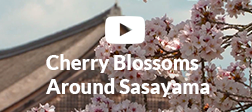The Flavor and Nutrition of Tamba Chestnuts
The large-sized Tamba chestnuts are famous throughout Japan for their high quality. Since ancient times, the former feudal lords of Tamba Sasayama often presented chestnuts as gifts to the imperial court.
While they contain mainly carbohydrates, chestnuts have other components as well, including sucrose. They also contain vitamins B1 and C and are easy to digest.
Tamba chestnuts are known as the "kings of chestnuts" in Japan because of their large kernels and mellow sweetness.
What is the secret behind their delicious flavor? One reason is the climate of Tamba Sasayama, which is ideal for chestnut growing. However, an equally important element is the time and effort growers devote to cultivating this popular product.
During the growing process of these gigantic chestnuts, it's sometimes necessary to prune the tree branches to moderately increase the nut production.
Harvesting begins once the chestnuts have fallen to the ground. When the nuts are gathered, they are sorted out, then undergo a hot water treatment to remove any possible trace of insecticides. Finally, the product is packaged in bags.
Tamba chestnuts require dedication and effort from every grower to become so delicious.
Try Tamba Chestnuts at the Tamba Sasayama Food Festival
Tamba chestnuts are in season from mid-September until mid-October. During this period, many out-of-town visitors make a special trip out here to buy these famed delicacies.
During the Tamba Sasayama Food Festival held annually in October, there's even an exhibition where harvested chestnuts from that year are on display and judged. Throughout the year, Tamba chestnuts also appear during the main events held in Tamba Sasayama.
Before the chestnuts are sold, they typically undergo a special hot water treatment to remove any possible insecticides and debris. If you decide to purchase some, it's a good idea to give them a quick wash when you get home.
After they have been washed, lay them out to dry in a shaded area. Afterward, place the chestnuts in a vented produce bag to prevent condensation, and then store them in the fridge.
Chestnuts have a shelf life of about two to three weeks in the refrigerator. The sugar content naturally increases once they are stored in the refrigerator, so it's probably best to let them sit for a few days beforehand.
Tamba chestnuts can be enjoyed in Japanese dishes such as kurigohan (steamed chestnut rice), yudeguri (boiled chestnuts), yakiguri (baked chestnuts), kuri kanroni (candied chestnuts), and kuri no shibukawani (Japanese-style chestnut compote).



